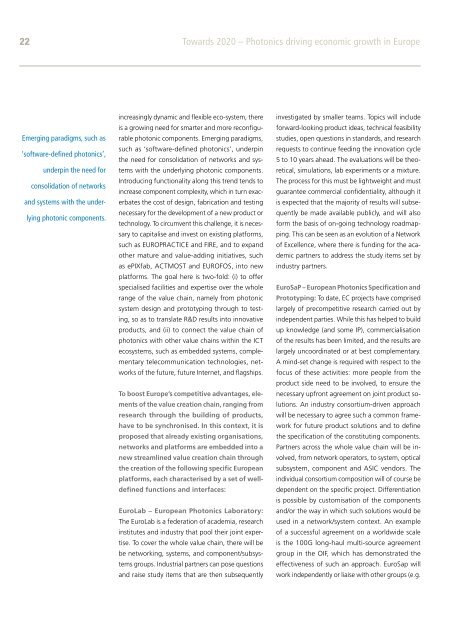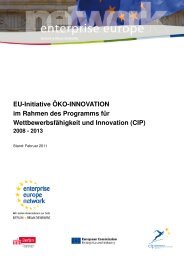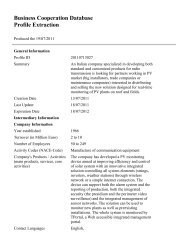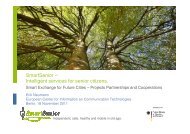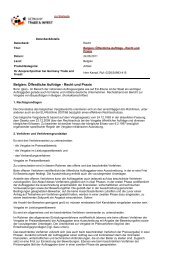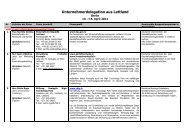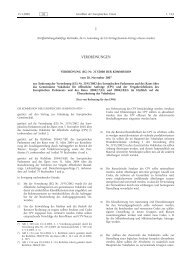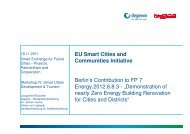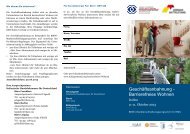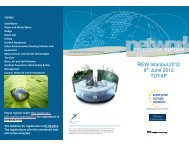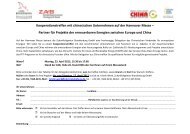Photonics Driving Economic Growth in Europe - Photonics21
Photonics Driving Economic Growth in Europe - Photonics21
Photonics Driving Economic Growth in Europe - Photonics21
You also want an ePaper? Increase the reach of your titles
YUMPU automatically turns print PDFs into web optimized ePapers that Google loves.
22 Towards 2020 – <strong>Photonics</strong> driv<strong>in</strong>g economic growth <strong>in</strong> <strong>Europe</strong><br />
Emerg<strong>in</strong>g paradigms, such as<br />
‘software-def<strong>in</strong>ed photonics’,<br />
underp<strong>in</strong> the need for<br />
consolidation of networks<br />
and systems with the under-<br />
ly<strong>in</strong>g photonic components.<br />
<strong>in</strong>creas<strong>in</strong>gly dynamic and flexible eco-system, there<br />
is a grow<strong>in</strong>g need for smarter and more reconfigu-<br />
rable photonic components. Emerg<strong>in</strong>g paradigms,<br />
such as ‘software-def<strong>in</strong>ed photonics’, underp<strong>in</strong><br />
the need for consolidation of networks and sys-<br />
tems with the underly<strong>in</strong>g photonic components.<br />
Introduc<strong>in</strong>g functionality along this trend tends to<br />
<strong>in</strong>crease component complexity, which <strong>in</strong> turn exac-<br />
erbates the cost of design, fabrication and test<strong>in</strong>g<br />
necessary for the development of a new product or<br />
technology. To circumvent this challenge, it is neces-<br />
sary to capitalise and <strong>in</strong>vest on exist<strong>in</strong>g platforms,<br />
such as EUROPRACTICE and FIRE, and to expand<br />
other mature and value-add<strong>in</strong>g <strong>in</strong>itiatives, such<br />
as ePIXfab, ACTMOST and EUROFOS, <strong>in</strong>to new<br />
platforms. The goal here is two-fold: (i) to offer<br />
specialised facilities and expertise over the whole<br />
range of the value cha<strong>in</strong>, namely from photonic<br />
system design and prototyp<strong>in</strong>g through to test<strong>in</strong>g,<br />
so as to translate R&D results <strong>in</strong>to <strong>in</strong>novative<br />
products, and (ii) to connect the value cha<strong>in</strong> of<br />
photonics with other value cha<strong>in</strong>s with<strong>in</strong> the ICT<br />
ecosystems, such as embedded systems, complementary<br />
telecommunication technologies, networks<br />
of the future, future Internet, and flagships.<br />
To boost <strong>Europe</strong>’s competitive advantages, elements<br />
of the value creation cha<strong>in</strong>, rang<strong>in</strong>g from<br />
research through the build<strong>in</strong>g of products,<br />
have to be synchronised. In this context, it is<br />
proposed that already exist<strong>in</strong>g organisations,<br />
networks and platforms are embedded <strong>in</strong>to a<br />
new streaml<strong>in</strong>ed value creation cha<strong>in</strong> through<br />
the creation of the follow<strong>in</strong>g specific <strong>Europe</strong>an<br />
platforms, each characterised by a set of welldef<strong>in</strong>ed<br />
functions and <strong>in</strong>terfaces:<br />
EuroLab – <strong>Europe</strong>an <strong>Photonics</strong> Laboratory:<br />
The EuroLab is a federation of academia, research<br />
<strong>in</strong>stitutes and <strong>in</strong>dustry that pool their jo<strong>in</strong>t expertise.<br />
To cover the whole value cha<strong>in</strong>, there will be<br />
be network<strong>in</strong>g, systems, and component/subsystems<br />
groups. Industrial partners can pose questions<br />
and raise study items that are then subsequently<br />
<strong>in</strong>vestigated by smaller teams. Topics will <strong>in</strong>clude<br />
forward-look<strong>in</strong>g product ideas, technical feasibility<br />
studies, open questions <strong>in</strong> standards, and research<br />
requests to cont<strong>in</strong>ue feed<strong>in</strong>g the <strong>in</strong>novation cycle<br />
5 to 10 years ahead. The evaluations will be theoretical,<br />
simulations, lab experiments or a mixture.<br />
The process for this must be lightweight and must<br />
guarantee commercial confidentiality, although it<br />
is expected that the majority of results will subsequently<br />
be made available publicly, and will also<br />
form the basis of on-go<strong>in</strong>g technology roadmapp<strong>in</strong>g.<br />
This can be seen as an evolution of a Network<br />
of Excellence, where there is fund<strong>in</strong>g for the academic<br />
partners to address the study items set by<br />
<strong>in</strong>dustry partners.<br />
EuroSaP – <strong>Europe</strong>an <strong>Photonics</strong> Specification and<br />
Prototyp<strong>in</strong>g: To date, EC projects have comprised<br />
largely of precompetitive research carried out by<br />
<strong>in</strong>dependent parties. While this has helped to build<br />
up knowledge (and some IP), commercialisation<br />
of the results has been limited, and the results are<br />
largely uncoord<strong>in</strong>ated or at best complementary.<br />
A m<strong>in</strong>d-set change is required with respect to the<br />
focus of these activities: more people from the<br />
product side need to be <strong>in</strong>volved, to ensure the<br />
necessary upfront agreement on jo<strong>in</strong>t product solutions.<br />
An <strong>in</strong>dustry consortium-driven approach<br />
will be necessary to agree such a common framework<br />
for future product solutions and to def<strong>in</strong>e<br />
the specification of the constitut<strong>in</strong>g components.<br />
Partners across the whole value cha<strong>in</strong> will be <strong>in</strong>volved,<br />
from network operators, to system, optical<br />
subsystem, component and ASIC vendors. The<br />
<strong>in</strong>dividual consortium composition will of course be<br />
dependent on the specific project. Differentiation<br />
is possible by customisation of the components<br />
and/or the way <strong>in</strong> which such solutions would be<br />
used <strong>in</strong> a network/system context. An example<br />
of a successful agreement on a worldwide scale<br />
is the 100G long-haul multi-source agreement<br />
group <strong>in</strong> the OIF, which has demonstrated the<br />
effectiveness of such an approach. EuroSap will<br />
work <strong>in</strong>dependently or liaise with other groups (e.g.


